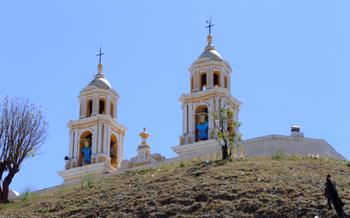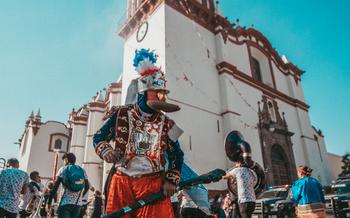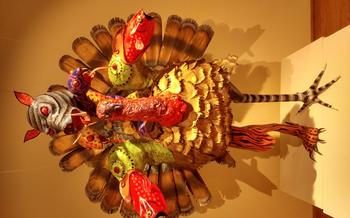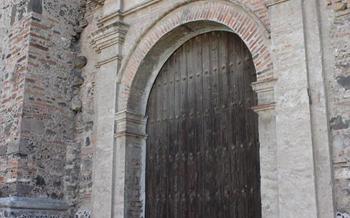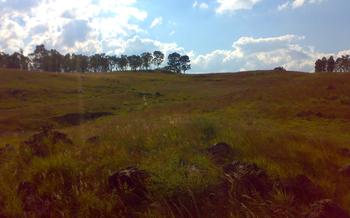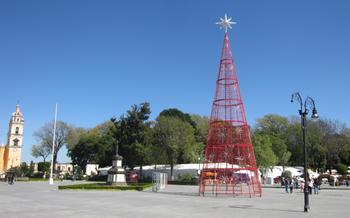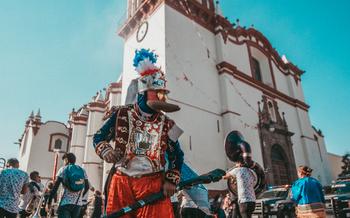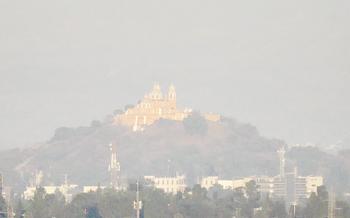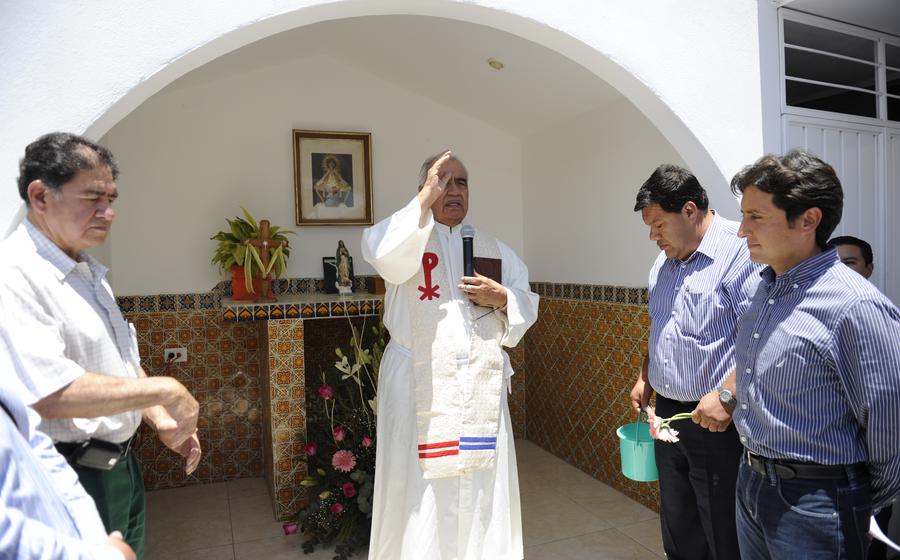
Cholula Pyramid Archaeological Zone
- Cholula Pyramid Archaeological Zone: A Historical Overview
- Exploring the Pyramid Complex: A Step-by-Step Guide
- Unveiling the Great Pyramid: Its Construction and Design
- Inside the Tunnels: A Journey Through Time
- The Myth and Legends of Cholula Pyramid
- Cholula's Magical Town: A Cultural Experience
- Museo Regional de Cholula: A Treasure Trove of Artifacts
- The View from the Top: Panoramic Vistas and Photo Opportunities
- Interactive Workshops and Cultural Demonstrations
- Local Cuisine and Culinary Delights
- Festivals and Cultural Events: A Vibrant Celebration
- Archaeological Research and Ongoing Discoveries
- Sustainable Tourism Practices: Treading Lightly
- Insider Tip: Hidden Gems and Secret Spots
Cholula Pyramid Archaeological Zone: A Historical Overview
The Cholula Pyramid, also known as Tlachihualtepetl ("made-by-hand mountain" in Nahuatl), stands as a testament to the ingenuity and architectural prowess of ancient Mesoamerican civilizations. Located in the heart of Cholula, Puebla, Mexico, this colossal pyramid holds a unique place in history and archaeology.
With a height of 66 meters (217 feet) and a base of 450 meters (1,476 feet) on each side, the Cholula Pyramid is the largest pyramid by volume in the world, surpassing even the Great Pyramid of Giza in Egypt. It was constructed over several centuries by the ancient Olmec, Xicalanca, and Toltec civilizations, each adding their own layers and modifications to the structure.
The pyramid served as a religious and ceremonial center, with a temple dedicated to Quetzalcoatl, the feathered serpent god, at its summit. It was a place of pilgrimage and worship for people from all over the region, and its size and grandeur reflected the power and prestige of the city of Cholula.
In the 16th century, the Spanish conquistadors, led by Hernán Cortés, destroyed the temple and built a Catholic church on top of the pyramid. This resulted in the pyramid being partially covered and obscured by the church and its surrounding structures.
In the 1930s, archaeological excavations began to uncover the true extent of the Cholula Pyramid. The removal of the church and other structures revealed a massive pyramid with a complex system of tunnels and chambers. Murals, sculptures, and other artifacts were discovered, providing valuable insights into the religious beliefs and daily life of the ancient inhabitants of Cholula.
Today, the Cholula Pyramid Archaeological Zone is a UNESCO World Heritage Site and a popular tourist destination. Visitors can explore the tunnels, climb to the top of the pyramid for panoramic views, and learn about the fascinating history and culture of this ancient city.
Exploring the Pyramid Complex: A Step-by-Step Guide
As you approach the Cholula Pyramid Archaeological Zone, its sheer size and grandeur will leave you in awe. The complex is laid out in a series of concentric squares, with the Great Pyramid at its center. Start your exploration at the base of the pyramid, where you can appreciate its impressive dimensions and the intricate stonework. As you ascend the pyramid, you'll encounter several levels, each offering unique perspectives and features.
The main attraction of the complex is undoubtedly the Great Pyramid, which stands at an impressive 66 meters (217 feet) tall. Climb the steep steps to reach the summit, where you'll be rewarded with breathtaking panoramic views of Cholula and the surrounding countryside. Along the way, keep an eye out for the various tunnels and chambers that have been excavated within the pyramid. These tunnels offer a glimpse into the ancient construction techniques and provide a unique perspective on the pyramid's interior.
Another highlight of the complex is the series of murals that adorn the walls of some of the tunnels. These murals depict scenes from ancient life, including religious rituals, everyday activities, and historical events. The murals are remarkably well-preserved and offer valuable insights into the culture and beliefs of the ancient Cholula people.
Don't miss the lesser-known features of the complex, such as the smaller pyramids and temples that surround the Great Pyramid. These structures, although smaller in size, offer their own unique charm and historical significance. Explore the various courtyards and plazas to discover hidden altars, sculptures, and other artifacts that provide clues to the past.
To capture the best shots of the Cholula Pyramid Archaeological Zone, plan your visit during the early morning or late afternoon when the lighting is most favorable. Use a wide-angle lens to capture the grandeur of the pyramid and the surrounding landscape. Experiment with different angles and perspectives to create dynamic and visually appealing compositions. Don't forget to take advantage of the panoramic views from the summit of the Great Pyramid for some truly breathtaking shots.
Unveiling the Great Pyramid: Its Construction and Design
The Great Pyramid of Cholula stands as a testament to the ingenuity and architectural prowess of ancient Mesoamerican civilizations. Constructed using adobe bricks and volcanic rock, the pyramid boasts a unique and distinctive appearance. Its stepped profile, composed of six superimposed platforms, rises majestically from the surrounding landscape.
Archaeological research suggests that the pyramid underwent several phases of construction, with each layer representing a different era. The earliest phase dates back to the 3rd century BC, when the pyramid's foundation was laid. Subsequent additions and modifications were made over the centuries, culminating in the massive structure we see today.
The symbolism associated with the Great Pyramid is deeply rooted in ancient Mesoamerican beliefs. The pyramid's alignment with the cardinal directions and its association with the god Quetzalcoatl, the feathered serpent deity, suggest its religious significance. The pyramid's orientation towards the rising sun during the spring and autumn equinoxes further reinforces this connection to celestial phenomena.
Comparisons with other pyramids in Mexico and Central America reveal both similarities and distinctions. While the Great Pyramid shares certain features with the pyramids of Teotihuacan, such as its stepped profile and orientation, it stands out due to its unique construction materials and its status as the largest pyramid by volume in the world.
Theories abound regarding the original purpose of the Great Pyramid. Some scholars believe it served as a religious temple, a place of pilgrimage, and a burial site for important individuals. Others suggest that it functioned as an astronomical observatory, aligning with celestial events. The ongoing exploration and study of the pyramid continue to shed light on its multifaceted significance in ancient Mesoamerican society.
Inside the Tunnels: A Journey Through Time
In 1931, archaeologists made a remarkable discovery beneath the Cholula Pyramid - a network of tunnels and chambers hidden within the structure. These tunnels, stretching over several kilometers, offer a glimpse into the ancient world and provide valuable insights into the lives and beliefs of the people who built this colossal monument.
The murals adorning the walls of the tunnels are particularly noteworthy. These vibrant and well-preserved paintings depict scenes from everyday life, religious ceremonies, and mythological stories. They offer a unique glimpse into the worldview of the ancient Cholulans and provide valuable information about their culture and beliefs.
Preserving and restoring these tunnels is an ongoing challenge for archaeologists and conservators. The humid environment and the constant flow of visitors can damage the delicate murals and structures. Special measures have been taken to control temperature and humidity levels within the tunnels, and visitors are required to follow strict guidelines to minimize their impact on the site.
The Myth and Legends of Cholula Pyramid
Beyond its historical significance, the Cholula Pyramid is deeply entwined with myth and legend, adding to its allure and mystique. Indigenous creation myths narrate how the pyramid was built by a giant named Xelhua, who was tasked with reaching the heavens and creating a new world after a great flood.
Legends abound, describing the pyramid's role in Aztec and Spanish history. According to Aztec mythology, the pyramid was a sacred site where the god Quetzalcoatl descended from the heavens. During the Spanish conquest, the pyramid became a refuge for indigenous people seeking protection from the conquistadors, who believed it held hidden treasures and secrets.
Archaeological evidence supports some of these legends. Excavations have uncovered tunnels and chambers beneath the pyramid, revealing artifacts and murals depicting ancient life and rituals. These findings have helped shed light on the pyramid's religious and cultural importance, further fueling the fascination and intrigue surrounding this enigmatic monument.
In modern times, the myths and legends of Cholula Pyramid continue to inspire and captivate visitors, inviting them to delve deeper into the rich history and cultural heritage of this ancient site.
Cholula's Magical Town: A Cultural Experience
Beyond the archaeological wonders, Cholula is a vibrant and captivating town steeped in history and culture. Take a leisurely stroll through its cobblestone streets, admiring the colonial architecture that seamlessly blends with the pre-Hispanic legacy. Visit the bustling markets, where vendors display an array of colorful handicrafts, fresh produce, and local delicacies. Step into the magnificent churches, each with its unique architectural style and sacred treasures. Discover the intriguing museums, showcasing the town's rich heritage through interactive exhibits and captivating displays.
Indulge in the flavors of Cholula's renowned cuisine, savoring the delectable mole poblano, a complex and flavorful sauce that has become a symbol of Mexican gastronomy. Don't miss the opportunity to try the traditional cemitas, a mouthwatering sandwich filled with various meats, cheeses, and vegetables. For a sweet treat, sample the delicious camotes, a local variety of sweet potato, often candied or cooked in syrup.
Cholula comes alive during its vibrant festivals and cultural events. Experience the joyous celebration of the annual Cholula Carnival, where the streets erupt with music, dance, and colorful parades. Witness traditional dances performed by locals adorned in elaborate costumes, accompanied by the enchanting melodies of indigenous instruments. Participate in workshops and demonstrations that showcase ancient techniques and modern adaptations of traditional crafts, such as weaving and pottery. Engage with local artisans and learn about the cultural significance of their work.
Immerse yourself in the warmth and hospitality of the Cholula people. Embrace the opportunity to connect with locals, listen to their stories, and gain a deeper understanding of their way of life. Respect the customs and traditions of the community, and contribute to the preservation of their cultural heritage.
Museo Regional de Cholula: A Treasure Trove of Artifacts
Nestled in the heart of Cholula's historic center, the Museo Regional de Cholula stands as a testament to the region's rich cultural heritage. Established in 1965, the museum houses an extensive collection of pre-Hispanic artifacts, pottery, and sculptures, offering visitors a glimpse into the ancient civilizations that once thrived in this region.
Interactive exhibits and educational displays bring the past to life, providing insights into the daily lives, customs, and beliefs of the pre-Columbian inhabitants of Cholula. Temporary exhibitions and special events add to the museum's dynamic offerings, showcasing the work of contemporary artists and highlighting specific aspects of Cholula's cultural heritage.
As you wander through the museum's galleries, you'll encounter a diverse array of artifacts, from intricately carved stone sculptures to delicate pottery vessels. The museum's collection includes pieces from various pre-Hispanic cultures, including the Olmecs, Zapotecs, Mixtecs, and Aztecs, offering a comprehensive overview of the region's artistic and cultural development.
The Museo Regional de Cholula plays a crucial role in preserving and promoting the cultural heritage of Cholula. Through its exhibitions, educational programs, and research initiatives, the museum contributes to a deeper understanding and appreciation of the region's rich history and cultural traditions.
The View from the Top: Panoramic Vistas and Photo Opportunities
As you ascend the colossal Cholula Pyramid, the landscape unfurls before you, revealing a picturesque tapestry of verdant valleys, distant mountains, and the sprawling cityscape of Cholula. The climb may be arduous, but the reward is immeasurable—a breathtaking panorama that will forever etch itself into your memory.
Upon reaching the summit, you'll be greeted by an unobstructed 360-degree vista that will leave you awestruck. Gaze out over the patchwork of fertile fields, dotted with traditional haciendas and villages. In the distance, the majestic volcanoes Popocatépetl and Iztaccíhuatl stand sentinel, their snow-capped peaks piercing the azure sky.
The city of Cholula itself is a sight to behold from this vantage point. Its colorful buildings, historic churches, and the iconic silhouette of the Great Pyramid create a captivating urban landscape. As the sun casts its golden rays, the cityscape transforms into a vibrant canvas of light and shadow, making it a photographer's paradise.
For the most dramatic lighting and the clearest views, plan your ascent to coincide with the golden hour—the magical period just before sunset or after sunrise. The warm hues of the rising or setting sun will bathe the landscape in a soft, ethereal glow, enhancing the beauty of the panorama.
To avoid the crowds and ensure a peaceful experience, consider visiting the pyramid early in the morning or late in the afternoon. These off-peak hours offer a more tranquil atmosphere, allowing you to fully appreciate the serenity and grandeur of this ancient site.
Interactive Workshops and Cultural Demonstrations
Cholula offers visitors a unique opportunity to engage in interactive workshops and cultural demonstrations that provide a deeper understanding of the region's rich heritage. These immersive experiences allow travelers to learn about traditional crafts, such as weaving and pottery, directly from local artisans. Participants can try their hand at creating their own crafts using ancient techniques that have been passed down through generations.
These workshops provide a hands-on approach to understanding the cultural significance of these crafts and the skills required to create them. Visitors can witness the meticulous process of weaving intricate patterns or the delicate shaping of clay into beautiful pottery. By engaging with local artisans and cultural practitioners, visitors not only support the preservation of indigenous traditions but also gain a deeper appreciation for the artistry and craftsmanship that goes into creating these unique works of art.
Local Cuisine and Culinary Delights
Cholula is a culinary paradise that offers a tantalizing array of traditional dishes, street food, and local specialties. Begin your culinary journey at the Mercado Cosme del Razo, a bustling marketplace where vendors display fresh produce, delectable cheeses, and handmade tortillas. Sample regional delights like memelas, thick corn cakes topped with beans, cheese, and salsa, or indulge in cemitas, savory sandwiches filled with meat, avocado, and smoky chipotle peppers.
For a taste of authentic Mexican cuisine, head to one of the many traditional restaurants in Cholula. Try mole poblano, a complex and flavorful sauce made with over 20 ingredients, served with tender chicken or pork. Another must-try is Cholula-style pozole, a hearty soup with hominy, meat, and a rich broth. Don't miss the chance to savor the region's famous sweets, such as sweet potato empanadas or the delicate pastries known as tortitas de Santa Clara.
When it comes to street food, Cholula is a haven for culinary adventurers. Sample fresh fruit salads, roasted corn, or the local favorite, esquites, a cup of corn kernels topped with mayonnaise, cheese, and chili powder. For a unique treat, try chapulines, grasshoppers that are toasted and seasoned with garlic, lime, and salt.
To immerse yourself fully in the local cuisine, participate in a cooking class and learn the secrets of preparing traditional Mexican dishes. Discover the art of making fresh tortillas, grinding your own spices, and creating flavorful salsas. Enjoy the fruits of your labor with a delicious meal shared with new friends.
Whether you're savoring traditional dishes in a local restaurant, indulging in street food delicacies, or learning to cook like a local, Cholula offers an unforgettable culinary experience that will tantalize your taste buds and leave you craving for more.
Festivals and Cultural Events: A Vibrant Celebration
Cholula's rich cultural heritage comes alive during its many festivals and events. The annual Cholula Carnival, held before Lent, is a spectacle of color, music, and dance. Floats, costumes, and traditional performances fill the streets as the city celebrates the arrival of spring.
Religious festivals and holidays are also a highlight of the Cholula calendar. The feast day of the city's patron saint, the Virgen de los Remedios, is celebrated in September with processions, fireworks, and traditional dances.
Throughout the year, visitors can enjoy traditional music, dance, and theater performances at the city's cultural centers and theaters. Local artisans showcase their skills at craft fairs and exhibitions, offering visitors a chance to purchase unique souvenirs and support the local economy.
Attending festivals and cultural events in Cholula is an immersive experience that allows visitors to connect with the city's vibrant cultural traditions and gain a deeper understanding of its history and heritage.
Archaeological Research and Ongoing Discoveries
The Cholula Pyramid Archaeological Zone continues to be a rich source of new discoveries and insights into ancient Mexican civilizations. In recent years, archaeological excavations have uncovered new structures, artifacts, and murals, shedding light on the complex history and religious significance of the site.
Non-invasive techniques like ground-penetrating radar and 3D laser scanning have revealed hidden chambers, tunnels, and platforms, providing valuable information about the pyramid's construction and layout. Ongoing research focuses on understanding the pyramid's astronomical alignments, water management systems, and the daily lives of the people who built and inhabited this sacred city.
Visitors to the archaeological zone can witness firsthand the ongoing work of archaeologists and researchers. Guided tours often include updates on the latest findings and provide an opportunity to learn about the challenges and rewards of archaeological research.
Participating in excavations or attending lectures and workshops organized by the archaeological team offers a unique chance to contribute to the ongoing study of Cholula and gain a deeper appreciation for the mysteries that this ancient site still holds.
Sustainable Tourism Practices: Treading Lightly
As responsible travelers, we have a duty to minimize our impact on the environment and respect the cultural heritage of the places we visit. When exploring the Cholula Pyramid Archaeological Zone, there are several ways to ensure our visit is sustainable and respectful. Supporting local businesses and initiatives is crucial for the economic well-being of the community. From purchasing souvenirs from local artisans to dining at family-run restaurants, our choices can directly benefit the preservation efforts. Additionally, respecting the cultural traditions and customs of the indigenous communities is essential. Engaging with locals with respect and curiosity allows us to learn from their perspectives and contribute positively to cross-cultural understanding.
By embracing eco-friendly practices, we can further reduce our ecological footprint. Reducing plastic waste, conserving water and energy, and choosing transportation options that minimize emissions are small steps that collectively make a significant impact. Walking or biking to the archaeological site not only promotes a healthier lifestyle but also reduces air pollution. Moreover, opting for guided tours led by local experts ensures we receive accurate information while supporting the local economy. By treading lightly and embracing sustainability, we can help preserve the Cholula Pyramid Archaeological Zone for future generations while fostering a deeper appreciation for its cultural and environmental significance.
Insider Tip: Hidden Gems and Secret Spots
Beyond the main attractions, Cholula Pyramid Archaeological Zone holds hidden gems and secret spots waiting to be discovered. Explore the lesser-known areas of the site, such as the smaller pyramids and temples scattered throughout the complex. Take a stroll through the surrounding countryside, where you'll find tranquil gardens, picturesque haciendas, and charming villages. For a unique experience, consider visiting during the early morning or late afternoon when the crowds are fewer, allowing you to soak in the tranquility and embrace the spiritual essence of this ancient site.
My personal favorite hidden gem is the small museum located within the archaeological zone. Here, you can view a collection of artifacts and learn more about the history and culture of the ancient Cholula people. The museum is often overlooked by visitors, but it's a treasure trove of information and offers a deeper understanding of this fascinating site.
Remember to respect the cultural significance of the site and tread lightly, minimizing your environmental impact. By doing so, you can help preserve this ancient wonder for future generations while enjoying a truly immersive and unforgettable experience.
